南北构造带是中国大陆构造域重要的东西分界线,是划分中国大陆东、西部地质、地貌特征明显不同的近N-S向延伸、组成结构十分复杂的地质构造带,也是显著的重力梯度带和地壳厚度突变带,它把中国大陆分成东西两个不同的构造作用区域,西部受到印度—欧亚板块碰撞造成的近南北向挤压作用,东部主要是由太平洋和菲律宾海板块俯冲和海沟后撤形成的伸展作用区域(李四光,1959;马杏垣,1987; 丁国瑜,1991; 邓起东等,2002).南北构造带也是一条活跃的强震带,被称为中国著名的南北地震带,我国大陆内部有历史记录以来一半的8级以上大地震发生在该带上,最近一次为2008年5月12日发生的四川汶川8级大地震(图 1).南北构造带南段位于青藏高原东南缘,受到印度—欧亚板块陆陆碰撞导致的青藏高原隆升和高原物质侧向挤出影响,地震活动频繁、地形变化剧烈、构造运动复杂,是探讨印度—欧亚板块碰撞造成陆内变形及其动力学过程的关键地区,长期以来为地球科学家所关注.该地区是中国大陆内部强烈地震发生的主要地区之一,一般认为,强烈地震的频繁发生与该地区的地壳结构和地球动力学过程有关.因此,通过分析地壳和上地幔变形特征对认识该区域地球动力学过程具有重要意义.
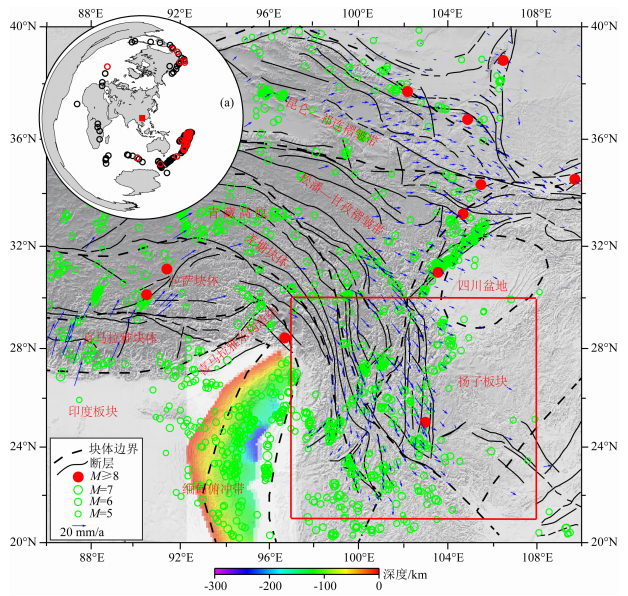 | 图 1 南北构造带及邻区构造简图(据任纪舜等,1980) 图中绿色圆圈为1970年以来5级以上地震,红色实心圆为8级以上历史地震.蓝色箭头代表GPS测量的地表运动速度场(Gan et al.,2007).插图a为本文选取的远震事件分布图,黑色圆圈是固定台站选取的事件,红色圆圈是流动台站选取的事件. Fig. 1 Major tectonic features map of North-South tectonic belt and surrounding regions(from Ren et al.,1980) Green circles show earthquakes with M>5 occurred since 1970s. Red solid circles mark historical earthquakes with M≥8. The study area in this paper is shown by the red square. Blue arrows display GPS velocity vectors calculated in the stable Eurasian reference frame(Gan et al.,2007). Inset(a)show epicenters of events used in the study. Black and red dots represent events recorded in permanent and temporary stations,respectively. |
地球动力学研究的一项基本内容是研究地壳和上地幔变形.地震各向异性研究是了解地壳和上地幔变形的有效方法之一.横波分裂现象是各向异性在地震波记录最明显的表现形式.快波偏振方向和快、慢波的时间延迟这两个参数分别反映了地幔变形的方向和强度.因此,从地震波传播中获得的各向异性信息有助于了解板块内部的变形特征,并推断与板块构造运动有关的下覆岩石圈的变形状况(Silver and Chan,1991).在中国大陆,一些学者利用横波分裂开展一系列上地幔各向异性的研究(如郑斯华和高原,1994; 丁志峰和曾融生,1996; 姜枚等,2001; 高原和滕吉文,2005; 李永华等,2010; Chang et al.,2012; 王椿镛等,2014).有关南北构造带南段的各向异性研究也一直受到地球科学工作者的关注(Flesch et al.,2005; 常利军等,2006,2008; Lev et al.,2006; Wang et al.,2008; Shi et al.,2012),然而,由于以前该区域的宽频带地震台站数量较少,而且分布不均,对该区域的各向异性特征很难从整体上来详细分析.最近,可与美国地震科学台阵(USArray)相媲美的中国地震科学探测台阵(ChinArray)项目开始实施,2011年到2013年之间,由中国地震局地球物理研究所牵头的中国地震科学探测台阵——南北地震带南段项目在研究区布设了350个宽频带流动地震台站,形成了密集且分布均匀的大型地震科学探测台阵.通过收集流动地震台站的远震波形记录,并结合研究区内中国国家地震台网的90个宽频带固定台站资料,使得我们能够对该区域的上地幔各向异性特征进行全面和详细的分析,并讨论其动力学含义.
2 数据地震资料来自于中国地震科学探测台阵——南北地震带南段项目(“喜马拉雅”项目一期)布设的350个宽频带流动地震台站,以及研究区内中国国家地震台网90个宽频带固定台站,总计440个台站记录的远震波形资料(图 2).流动地震台阵观测时间为2011年8月到2013年9月,流动地震台站的宽频带地震计为CMG-3ESPC,频带范围为50 Hz~60 s.选取的大部分固定台站观测时间为2008年1月到2012年12月,部分台站从2003年开始,台站的记录时间取决于各个台站开始运行的时间.
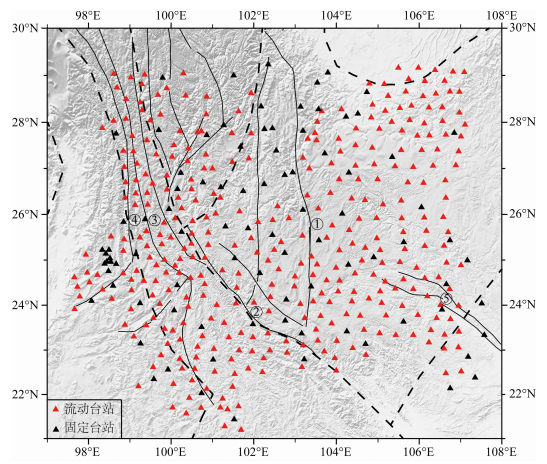 | 图 2 研究区构造简图及地震台站分布图 黑色实线为断裂,主要断裂为 ① 小江断裂,② 红河断裂,③ 澜沧江断裂,④ 怒江断裂,⑤ 百色—合浦断裂.虚线为块体边界. Fig. 2 Regional geologic setting of the study area and location of stations Black lines show main faults: ① Xiaojiang Fault, ② Honghe Fault, ③ Lancangjiang Fault, ④ Nujiang Fault, ⑤ Baise-Hepu Fault. Dashed lines represent boundaries between blocks. |
用于XKS(XKS为SKS、SKKS和PKS震相的统称)波分裂测量的远震事件选取的标准是:地震震级大于5.5级的深源地震(震源深度>150 km)或震级大于6级的浅源地震(震源深度小于<150 km),震中距在85°~135°范围内地震(85°~120°范围内的SKS震相,120°~130°范围内的SKKS震相和125°~135°范围内的PKS震相).为获得可靠的横波分裂参数,选取的地震事件要求XKS震相波形清晰,并且没有受到其他震相和背景噪声的干扰.图 1的插图a显示了本文用于XKS波分裂测量的地震事件分布,固定台站记录时间长,选取了296个远震事件(黑色圆圈),流动台站记录时间相对较短,选取了104个远震事件(红色圆圈).地震事件主要集中在南太平洋地区的斐济—汤加一带,其他地区也有一定分布,提高了地震事件的方位覆盖.
3 方法本文使用的XKS波分裂测量分析方法分以下两步:(1)用最小切向能量的网格搜索法(Silver and Chan,1991)分析不同方位的单个事件确定的各向异性参数(φ,δt)及其误差,解的误差估计用F-试验的置信区域来表示,置信度一般为95%.其基本步骤为:选取的XKS波在旋转到径向和切向坐标轴上,切向分量要明显,且质点运动图为椭圆,以表明横波具有明显的分裂特征.通过横波分裂分析测量得到横波分裂参数后,在进行各向异性校正后,横波旋转到径向和切向坐标轴上,切向分量变得很小,且质点运动图为近似直线.各向异性校正前的快、慢波之间有明显的到时差,且质点运动图为椭圆;校正后的快、慢波之间的到时差变得很小,且质点运动图近似为直线.以此判断横波分裂参数的可信度.图 3显示了对2013年5月23日21点07分汤加群岛MW6.2级地震在53004台的记录所作的XKS波分裂分析.
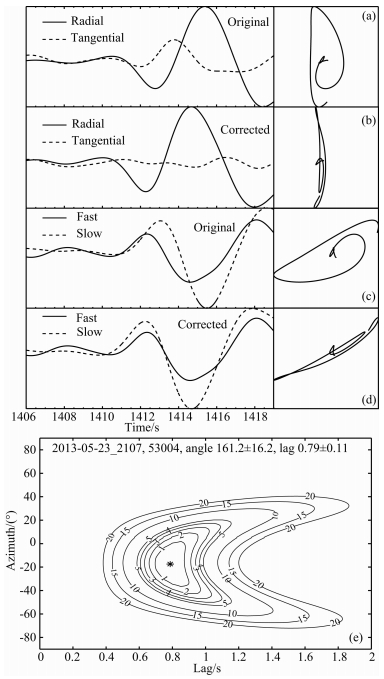 | 图 3 XKS波分裂分析示例 (a) 原始的径向和切向上的波形和质点运动; (b) 经过各向异性校正后的径向和切向上的波形和质点运动; (c) 原始XKS震相转到快波和慢波轴方向的波形和质点运动; (d) 经过各向异性校正后XKS震相在快波和慢波轴方向的波形和质点运动; (e) 切向能量等值线图,星号处对应了最佳的分裂参数. Fig. 3 Shear wave splitting analysis for an XKS event recorded at station 53004 (a) The radial and tangential components; (b) The radial and tangential components after the energy in the tangential component has been removed; (c) The components from Fig.2a rotated to the fast and slow directions, and (d) the fast and shifted slow components. Particle motion is shown to the right of each seismogram; (e) Contour plot of the energy on the corrected tangential component for event 2013-05-23 21∶07 with MW6.2. Black asterisk shows the best estimate. |
(2)对一组由远震事件测量得到的台站下方各向异性参数做“叠加”分析处理(Wolfe and Silver,1998).将N个事件的切向能量Et(φ,δt)i按照Et(φ,δt)=ΣEt(φ,δt)i进行求和,并用网格搜索Et(φ,δt)中最小的切向能量,与之相对应的那个参数对便是该台站下方最终的各向异性参数,相应的误差估计也用同样的方法处理.对于不同信噪比、从不同方位来的远震XKS波,这种方法能够提高结果的可靠性.对于干扰背景较大的台站,效果尤为明显.因此,“叠加”分析是提高横波分裂测量质量的一种有效方法.图 4显示了53004台从5个远震事件(2011年12月11日1点47分MW6.5;2011年9月22日23点07分MW6.3;2012年5月29日3时33分MW5.9;2013年4月26日6时53分MW6.2;2013年5月23日21时07分MW6.3)获得的XKS波分裂分析结果(图 4a、4b、4c、4d和4e)与使用“叠加”处理后结果(图 4f)的比较,这5个分裂参数误差较大的事件,经过叠加之后最终分裂参数的误差明显减小.
 | 图 4 53004台单个远震事件XKS波分裂分析的切向能量等值线图(a、b、c、d、e)以及由这五个事件叠加得到的切向能量等值线图(f),图中星号表示最佳分裂参数的位置 Fig. 4 Tangential energy contour of XKS splitting analysis from three teleseismic events (a, b, c, d and e), and the stacked tangential energy contour (f) at station 53004. The asterisk denotes the position of optimal parameter pair |
通过采用最小切向能量的网格搜索法和“叠加”分析方法求得了每一个台站的XKS波的快波偏振方向和快、慢波的时间延迟,表 1列出了南北地震带南段440个地震台站得到的横波分裂参数叠加结果.固定台站的台基一般为基岩,背景噪音低,运行时间较长,可用于分析的远震事件较多,因而XKS波分裂测量的质量高.尽管流动台站的观测条件相对固定台站较差,但2年多的观测可获得用于XKS波分裂测量的远震记录较多,并且在单个事件分析的基础上进行“叠加”分析处理,因而大多数流动台站的分裂测量结果也比较好.从得到的结果来看,大多数台站的测量结果质量都比较高,其快波方向的误差在10°以内,时间延迟的误差在0.2 s以内.
|
|
表 1 研究区各台站XKS波分裂参数 Table 1 Splitting parameters for XKS phases in the study area |
基于表 1中各台站得到的分裂参数,获得了南北构造带南段目前最全面的上地幔各向异性图像(图 5、图 6和图 7).根据南北构造带南段快波方向分布图(图 5和图 7)可以看出,流动台站的结果与相邻固定台站的结果一致性很好,以~N26.5°为界,快波方向在北部主要表现为近N-S方向,在南部主要表现为近E-W方向,快波方向的南北分区特征明显.根据研究区快、慢波时间延迟分布图(图 6)来看,总体上也存在南北分区的特征,南部的平均时间延迟为1.1 s,北部的平均时间延迟为0.8 s,特别是研究区内扬子板块的时间延迟南北分区分布特征明显.在研究区南部西侧的腾冲火山地区表现出独特性,快波方向为NW-SE方向,时间延迟较小,平均值为0.7 s.本文得到的结果与其他研究者在相同区域结果进行比较显示,本文与其他学者得到的相同位置的固定台站(Shi et al.,2012)和相邻流动台站的结果(Flesch et al.,2005; Lev et al.,2006)基本一致.
 | 图 5 南北构造带南段各台站XKS波分裂测量结果 红色直线段为流动台阵的结果,蓝色直线段为固定台站的结果.线段的方向表示快波方向,线段的长度表示时间延迟的大小. Fig. 5 XKS splitting results in the southern segment of North-South tectonic belt Red bars and blue bars represent the splitting measurements at temporary stations and permanent stations, respectively. The orientations and length of bar indicate the fast polarization direction and the delay time, respectively. |
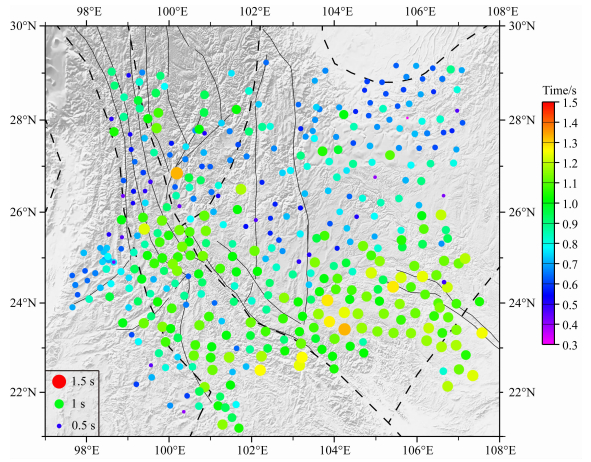 | 图 6 南北构造带南段快、慢波时间延迟分布图 Fig. 6 The distribution of delay times in the southern segment of North-South tectonic belt |
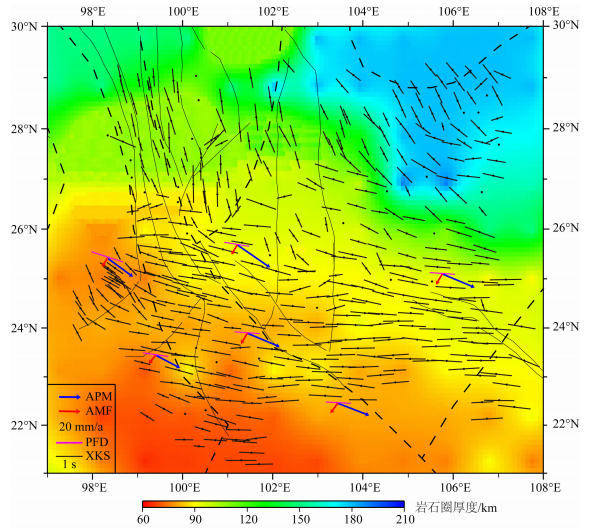 | 图 7 南北构造带南段各台站XKS波分裂测量结果和岩石圈厚度分布 红色箭头为软流圈地幔流(AMF),蓝色箭头为绝对板块运动(APM),黑色直线段为XKS波分裂测量结果,红色直线段为预测的快波方向(PFD). Fig. 7 Map displaying shear wave splitting parameters and lithospheric thickness in the study area Red and blue arrows represent the vectors of asthenospheric mantle flow (AMF) and absolute plate motion (APM), respectively. The observed shear wave splitting data (XKS) and predicted fast direction (PFD) are plotted black and pink bars, respectively. |
用XKS波分裂来研究各向异性,在横向上具有很高的分辨率,但是在其传播路径上很难确定各向异性层的深度.地壳和地幔都可能存在各向异性层,并且各向异性可以解释为岩石圈的变形,也可以归因于软流圈地幔流.下面的约束可以帮助我们认识南北构造带南段各向异性层的分布.在南北构造带南段,通过Moho界面的Ps转换波得到的该区域整个地壳各向异性产生的平均时间延迟为0.19 s(Chen et al.,2013).根据上地幔橄榄岩及其他矿物的含量和实验室的测量结果,假设该区域地幔的各向异性度为3.7%(Mainprice and Silver,1993),并取平均 S 波速度为 4.60 km·s-1,在研究区南部1.1 s的平均分裂时间延迟估算的各向异性层厚度为138 km,北部0.9 s的平均时间延迟估算的各向异性层厚度为112 km.通过一阶Fresnel带(Alsina and Snieder,1995)的推断,研究区各向异性层分布在60~160 km之间,与青藏高原东南缘他人研究结果基本一致(Lev et al.,2006).南北构造带南段的壳幔结构研究表明,地壳厚度和岩石圈厚度在研究区南北有着明显的差别,人工地震探测(滕吉文等,2002)和接收函数(李永华等,2009; 王兴臣等,2015)研究得到在南部的平均地壳厚度为~40 km,而北部地区的平均地壳厚度为~60 km;地震-热学岩石圈厚度(An and Shi,2006)研究显示在南部的平均岩石圈为~80 km,而北部的平均岩石圈厚度达~160 km(图 7).在研究区南部,即使假设地壳和壳下岩石圈变形一致,去掉地壳影响,40 km厚的壳下岩石圈不足以产生南部观测到的0.9 s的平均时间延迟(扣除~0.2 s的地壳各向异性分裂时间延迟).综合以上分析,在研究区南部的各向异性层主要分布在岩石圈软流圈,而北部的各向异性层主要位于岩石圈.
5.2 各向异性成因上地幔各向异性是由于应变作用导致地幔橄榄岩等矿物的晶格优势排列引起的(Nicolas et al.,1973; Zhang and Karato,1995),因此横波分裂测量结果直接反映了地幔变形和地幔流的特征(Silver,1996).通过分析地幔变形场与各向异性之间的关系,人们认识到横波分裂参数是描述地球介质变形的关键参数之一.在板块驱动的假设下,当前流行两个壳幔变形运动学的端元模型,即简单软流圈流动(Vinnik et al.,1989; Silver and Holt,2002)和垂直连贯变形(Silver,1996).简单软流圈流动则意味着板块自驱动,并由力学上软弱的软流圈与岩石圈有效解耦,地幔变形归因于软流圈顶部和底部的差异速度.岩石圈垂直连贯变形预示地壳强烈地耦合于地幔,地幔变形场和地表变形场是相同的,快波方向平行于造山带和大型走滑断裂的走向.
根据GPS测量确定的地表运动速度场(Gan et al.,2007)来看(图 1中插图a),研究区北部地表主要向南运动,南部呈扇形发散状,靠近缅甸弧后地区为西南向,中间为向南运动,东面的扬子板块运动方向逐渐转向东南.在研究区北部,快波方向与地表运动速度场方向表现出一致性,并且与区域内地表构造(断层和山脉)走向一致,说明深部上地幔变形特征与地表变形特征相一致,预示了地幔岩石圈变形场和地表变形场是一致的,岩石圈变形为垂直连贯变形模式.在研究区南部,快波方向由N-S方向突变为E-W方向,与该区域地表运动场方向和地表构造走向差别很大,说明深部软流圈地幔流动场与地表变形场不一致.由NNR-NUVEL1a模型(DeMets et al.,1994)求取的欧亚板块相对于NNR(No-Net-Rotation)参考系下的绝对板块运动(APM)方向(图 7),在研究区南部表现为NWW方向,与该区域快波方向基本一致,且相对于快波方向有一个顺时针系统的角度差,二者的平均角度差为17°,说明该区域的各向异性主要由软流圈地幔流引起,并预示了可能存在一个小尺度的地幔流.依据Silver和Holt(2002)关于简单软流圈地幔流模型,Wang等(2013)利用固定台站的结果模拟了华南地区的软流圈地幔流(AMF),并预测了地幔流导致的各向异性快波方向(PFD)(图 7).根据模拟结果,在本文研究区南部附加了一个西南方向~15 mm·a-1的地幔流后,预测的快波方向与XKS波测量的快波方向一致性进一步增强,二者的平均角度差减小为10°.缅甸俯冲带的几何结构(图 1)(张浪平等,2013)和地震层析成像研究(Li and Van Der Hilst,2010)揭示了缅甸板片的东向俯冲.在云南地区下方100~300 km之间存在一个P波低速异常体(Li and Van Der Hilst,2010; Wang et al.,2003),提供了由于缅甸板片后撤引起的小尺度地幔对流的地震学证据.沿印度-澳大利亚板块的现今俯冲板片几何形态的构造重建研究提供了缅甸和巽达俯冲带的演化过程(Richards et al.,2007),缅甸和巽达板片向东北俯冲的同时,存在一个向西南后撤/回转(retreat/rollback)过程.受缅甸和巽达板片的后撤/回转的作用,产生了指向西南的软流圈地幔流,在研究区南部岩石圈底部和软流圈之间产生了一个水平差异运动,产生了一个与简单剪切一致的软流圈变形结构,产生了南部观测到的近E-W方向的各向异性.
5.3 结论本文利用南北构造带南段密集分布的440个宽频带地震台站的横波分裂参数结果,获得了目前该区域最全面的上地幔各向异性图像.研究区南北具有明显的各向异性分区特征,北部的快波方向为近N-S方向,而南部主要表现为近E-W方向,并且北部的平均快、慢波时间延迟明显小于南部.北部的快波方向与地表运动场和地表构造走向一致,说明该区域地表变形特征与深部上地幔变形特征是一致的,预示了其岩石圈变形符合垂直连贯变形模式.具有较薄岩石圈的南部的快波方向与NNR参考系下岩石圈绝对板块运动方向基本一致,在假设存在一个西南向的小尺度地幔流情况下,预测的快波方向与测量的快波方向的一致性进一步增强.我们认为一种可能的机制为受到缅甸和巽达板片的后撤/回转的作用,产生了指向西南的软流圈地幔流,从而产生了南部观测的各向异性.
致谢 所有参与中国地震科学探测台阵(ChinArray)项目的规划者和实施者为确保获取高质量的地震数据付出了努力.感谢中国地震局地球物理研究所“地震科学探测台阵数据中心”为本研究提供地震波形数据.
| [1] | Alsina D, Snieder R. 1995. Small-scale sublithospheric continental mantle deformation: constraints from SKS splitting observations. Geophys. J. Int., 123(2): 431-448. |
| [2] | An M J, Shi Y L. 2006. Lithospheric thickness of the Chinese Continent. Phys. Earth Planet. Int., 159(3-4): 257-266. |
| [3] | Chang L J, Wang C Y, Ding Z F. 2006. A study on SKS splitting beneath the Yunnan region. Chinese J. Geophys. (in Chinese), 49(1): 197-204. |
| [4] | Chang L J, Wang C Y, Ding Z F. 2008. Seismic anisotropy of upper mantle in Sichuan and adjacent regions. Sci. China Ser. D-Earth Sci., 51(12): 1683-1693. |
| [5] | Chang L J, Wang C Y, Ding Z F. 2012. Upper mantle anisotropy beneath North China from shear wave splitting measurements. Tectonophysics, 522-523: 235-242. |
| [6] | Chen Y, Zhang Z J, Sun C Q, et al. 2013. Crustal anisotropy from Moho converted Ps wave splitting analysis and geodynamic implications beneath the eastern margin of Tibet and surrounding regions. Gondwana Res., 24(3-4): 946-957. |
| [7] | DeMets C, Gordon R G, Argus D F, et al. 1994. Effect of recent revisions to the geomagnetic reversal time scale on estimate of current plate motions. Geophys. Res. Lett., 21: 2191-2194. |
| [8] | Deng Q D, Zhang P Z, Ran Y K, et al. 2003. Basic characteristics of active tectonics of China. China Ser. D-Earth Sci., 46(4): 356-372. |
| [9] | Ding G Y. 1991. A Summary for the Lithosphere Dynamics of China (in Chinese). Beijing: Seismological Press. |
| [10] | Ding Z F, Zeng R S. 1996. Observation and study of shear wave anisotropy in Tibetan Plateau. Acta Geophysica Sinica (in Chinese), 39(2): 211-220. |
| [11] | Flesch L M, Holt W E, Silver P G, et al. 2005. Constraining the extent of crust-mantle coupling in Central Asia using GPS, geologic, and shear wave splitting data. Sci. Lett.Earth Planet. , 238(1-2): 248-268. |
| [12] | Gan W J, Zhang P Z, Shen Z K, et al. 2007. Present-day crustal motion within the Tibetan Plateau inferred from GPS measurements. J. Geophys. Res., 112: B08416, doi: 10.1029/2005JB004120. |
| [13] | Gao Y, Teng J W. 2005. Studies on seismic anisotropy in the crust and mantle on Chinese Mainland. Progress Geophys. (in Chinese), 20(1): 180-185. |
| [14] | Jiang M, Xu Z Q, Hirn A, et al. 2001. Teleseimic anisotropy and corresponding features of the upper mantle in Tibet Plateau and its neighboring areas. Acta Geosci. Sin. (in Chinese), 22(2): 111-116. |
| [15] | Lev E, Long M D, Van der Hilst R D. 2006. Seismic anisotropy in eastern Tibet from shear wave splitting reveals changes in lithospheric deformation. Earth Planet. Sci. Lett., 251(3-4): 293-304. |
| [16] | Li C, Van Der Hilst R D. 2010. Structure of the upper mantle and transition zone beneath Southeast Asia from traveltime tomography. J. Geophys. Res., 115: B07308, doi: 10.1029/2009JB006882. |
| [17] | Li S G. 1959. The east-west trending complex tectonic zone and the north south trending tectonic zone. Collections of Geomechanics (in Chinese), (1): 5-14. |
| [18] | Li Y H, Wu Q J, Tian X B, et al. 2009. Crustal structure in the Yunnan region determined by modeling receiver functions. Chinese J. Geophys. (in Chinese), 52(1): 67-80. |
| [19] | Li Y H, Wu Q J, Feng Q Q, et al. 2010. Seismic anisotropy beneath Qinghai province revealed by shear wave splitting. Chinese J. Geophys. (in Chinese), 53(6): 1374-1383. |
| [20] | Ma X Y. 1987. An Outline for Lithosphere Dynamics of China (in Chinese). Beijing: Geological Publishing House. |
| [21] | Mainprice D, Silver P G. 1993. Interpretation of SKS-waves using samples from the subcontinental lithosphere. Phys. Earth Planet. Int., 78(3-4): 257-280. |
| [22] | Nicolas A, Boudier F, Boullier A M. 1973. Mechanisms of flow in naturally and experimentally deformed peridotites. Am. J. Sci., 273(10): 853-876. |
| [23] | Ren J S, Jiang C F, Zhang Z K, et al. 1980. Geotectonic Evolution of China (in Chinese). Beijing: Science Press. 124 |
| [24] | Richards S, Lister G, Kennett B. 2007. A slab in depth: Three-dimensional geometry and evolution of the Indo-Australian plate. Geochem. Geophys. Geosyst., 8(12): Q12003, doi: 10.1029/2007GC001657. |
| [25] | Shi Y T, Gao Y, Su Y J, et al. 2012. Shear-wave splitting beneath Yunnan area of Southwest China. Earthq. Sci., 25(1): 25-34. |
| [26] | Silver P G, Chan W W. 1991. Share-wave splitting and subcontinental mantle deformation. J. Geophys. Res., 96(B10): 16429-16454. |
| [27] | Silver P G. 1996. Seismic anisotropy beneath the continents: Probing the depths of geology. Ann. Rev. Earth Planet. Sci., 24(1): 385-432. |
| [28] | Silver P G, Holt W E. 2002. The mantle flow field beneath western North America. Science, 295(5557): 1054-1057. |
| [29] | Teng J W, Zeng R S, Yan Y F, et al. 2002. The depth distribution of Moho and tectonic framework in eastern Asian continent and its adjacent ocean areas. Sci. China Ser. D-Earth Sci., 32(2): 89-100. |
| [30] | Vinnik L P, Farra V, Romanowicz B. 1989. Azimuthal anisotropy in the Earth from observations of SKS at Geoscope and NARS broadband stations. Bull. Sesimol. Soc. Amer., 79(5): 1452-1558. |
| [31] | Wang C Y, Chan W W, Mooney W D. 2003. Three-dimensional velocity structure of crust and upper mantle in southwestern China and its tectonic implications. J. Geophys. Res., 108(B9): 2442, doi: 10.1029/2002JB001973. |
| [32] | Wang C Y, Flesch L M, Chang L J, et al. 2013. Evidence of active mantle flow beneath South China. Geophys. Res. Lett., 40: 5137-5141. |
| [33] | Wang C Y, Flesch L M, Silver P G, et al. 2008. Evidence for mechanically coupled lithosphere in central Asia and resulting implications. Geology, 36(5): 363-366. |
| [34] | Wang C Y, Chang L J, Ding Z F, et al. 2014. Upper mantle anisotropy and crust-mantle deformation pattern beneath the Chinese mainland. Sci. China Ser. D-Earth Sci., 57(1): 132-143. |
| [35] | Wang X C, Ding Z F, Wu Y, et al. 2015. The crustal structure and seismogenesis in the Ludian MS6.5 earthqauke region. Chinese J. Geophys. (in Chinese), 58(11):4031-4040,doi:10.6038/cjg20151112. |
| [36] | Wolfe C J, Silver P G. 1998. Seismic anisotropy of oceanic upper mantle: Shear wave splitting methodologies and observations. J. Geophys. Res., 103(B1): 749-771. |
| [37] | Zhang L P, Shao Z G, Ma H S, et al. 2013. The plate contact geometry investigation based on earthquake source parameters at the Burma arc subduction zone. Sci. China Earth Sci, 56(5): 806-817. |
| [38] | Zhang S Q, Karato S. 1995. Lattice preferred orientation of olivine aggregates deformed in simple shear. Nature, 375(6534): 774-777. |
| [39] | Zheng S H, Gao Y. 1994. Azimuthal anisotropy of lithosphere in the Chinese continent. Acta Seism. Sin. (in Chinese), 16(2): 131-140. |
| [40] | 常利军, 王椿镛, 丁志峰. 2006. 云南地区SKS波分裂研究. 地球物理学报, 49(1): 197-204. |
| [41] | 常利军, 王椿镛, 丁志峰. 2008. 四川及邻区上地幔各向异性研究. 中国科学(D辑), 38(12): 1589-1599. |
| [42] | 邓起东, 张培震, 冉勇康等. 2002. 中国活动构造基本特征. 中国科学(D辑), 32(12): 1020-1030. |
| [43] | 丁国瑜. 1991. 中国岩石圈动力学概论. 北京: 地震出版社. |
| [44] | 丁志峰, 曾融生. 1996. 青藏高原横波分裂的观测研究. 地球物理学报, 39(2): 211-220. |
| [45] | 高原, 滕吉文. 2005. 中国大陆地壳与上地幔地震各向异性研究. 地球物理学进展, 20(1): 180-185. |
| [46] | 姜枚, 许志琴, Hirn A等. 2001. 青藏高原及其部分邻区地震各向异性和上地幔特征. 地球学报, 22(2): 111-116. |
| [47] | 李四光. 1959. 东西复杂构造带和南北构造带. 地质力学丛刊, (1): 5-14. |
| [48] | 李永华, 吴庆举, 田小波等. 2009. 用接收函数方法研究云南及其邻区地壳上地幔结构. 地球物理学报, 52(1): 67-80. |
| [49] | 李永华, 吴庆举, 冯强强等. 2010. 青海地区S波分裂研究. 地球物理学报, 53(6): 1374-1383. |
| [50] | 马杏垣. 1987. 中国岩石圈动力学纲要. 北京: 地质出版社. |
| [51] | 任纪舜, 姜春发, 张正坤等. 1980. 中国大地构造及其演化—1∶400万中国大地构造图简要说明. 北京: 科学出版社. 124. |
| [52] | 滕吉文, 曾融生, 闫雅芬等. 2002. 东亚大陆及周边海域Moho界面深度分布和基本构造格局. 中国科学(D辑), 32(2): 89-100. |
| [53] | 王椿镛, 常利军, 丁志峰等. 2014. 中国大陆上地幔各向异性和壳幔变形模式. 中国科学: 地球科学, 44(1): 98-110. |
| [54] | 王兴臣, 丁志峰, 武岩等. 2015. 鲁甸MS6.5地震震源区地壳结构及孕震环境研究. 地球物理学报,58(11):4031-4040,doi:10.6038/cjg20151112. |
| [55] | 张浪平, 邵志刚, 马宏生等. 2013. 基于地震参数的缅甸弧俯冲带处板块间几何接触方式的研究. 中国科学(D辑), 43(4): 653-664. |
| [56] | 郑斯华, 高原. 1994. 中国大陆岩石层的方位各向异性. 地震学报, 16(2): 131-140. |
 2015, Vol. 58
2015, Vol. 58

